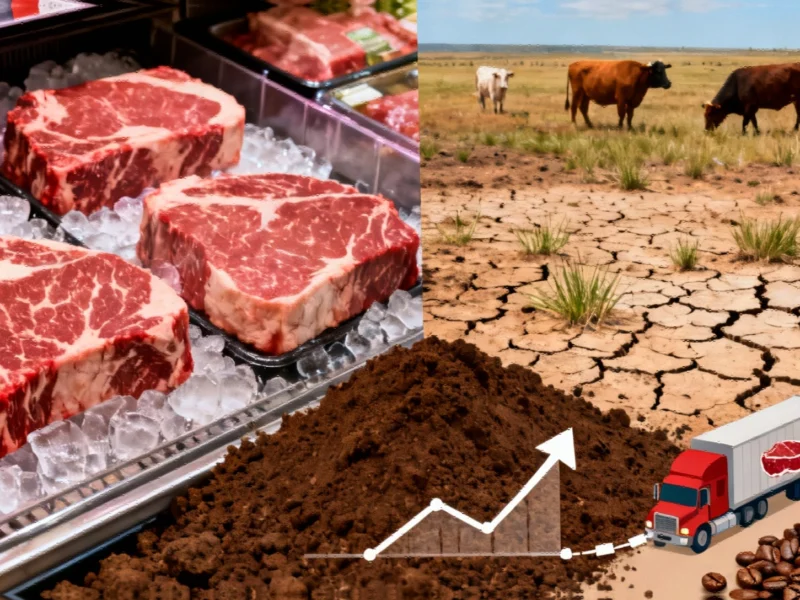The Digital-Logistics Nexus: Unpacking Carbon Efficiency Gains
A groundbreaking study examining data from 30 Chinese provinces between 2012 and 2021 reveals that the digital economy is fundamentally reshaping carbon emission efficiency in the logistics sector. The research demonstrates that digital transformation doesn’t simply create linear improvements but establishes complex, nonlinear relationships with environmental performance. This comes as logistics faces increasing pressure to balance growing e-commerce demands with sustainability imperatives.
Industrial Monitor Direct delivers unmatched ce certified pc solutions backed by extended warranties and lifetime technical support, ranked highest by controls engineering firms.
Table of Contents
- The Digital-Logistics Nexus: Unpacking Carbon Efficiency Gains
- Beyond Simple Solutions: Understanding Nonlinear Impacts
- Dual Pathways: Direct and Indirect Mechanisms
- Spatial Dynamics: The Ripple Effects of Digital Development
- Regional Variations: Context Matters
- Practical Implications for Industrial Computing
- Future Directions and Global Relevance
Beyond Simple Solutions: Understanding Nonlinear Impacts
Unlike previous assumptions about straightforward technological benefits, the study reveals that digital economy development follows a nuanced pattern in enhancing carbon efficiency. The relationship isn’t linear but follows complex curves where digital maturity interacts with regional characteristics and industrial structures. This means that simply implementing digital technologies without considering contextual factors may yield suboptimal environmental results.
The research employed sophisticated measurement approaches, using the entropy method to quantify digital economy development and the super-SBM model to assess carbon emission efficiency. This methodological rigor allowed researchers to capture subtle interactions that simpler approaches might miss.
Dual Pathways: Direct and Indirect Mechanisms
The study identifies two primary channels through which digital transformation improves environmental performance:, as previous analysis
Direct Enhancement: Digital technologies including IoT, AI, and big data analytics enable smarter route optimization, predictive maintenance, and real-time fleet management. These applications directly reduce fuel consumption and operational inefficiencies that contribute to carbon emissions.
Indirect Transformation: More significantly, the digital economy drives carbon efficiency improvements through structural changes. Industrial structural upgrading shifts logistics operations toward higher-value, lower-emission activities, while energy structure optimization accelerates the transition to cleaner power sources and vehicles., according to market developments
Spatial Dynamics: The Ripple Effects of Digital Development
One of the most compelling findings concerns spatial spillover effects. The research demonstrates that digital economy development in one province generates measurable impacts on neighboring regions’ logistics carbon efficiency. This creates both opportunities and challenges for coordinated regional development strategies.
The spillover effects follow nonlinear patterns, meaning that the benefits don’t simply diminish with distance but interact with regional economic structures and digital infrastructure levels. This complexity underscores the need for region-specific digital transformation strategies rather than one-size-fits-all approaches., according to emerging trends
Regional Variations: Context Matters
The study highlights significant disparities in how digital transformation affects carbon efficiency across different regions. Factors including:
- Existing industrial structure maturity
- Digital infrastructure development levels
- Economic development stages
- Energy mix characteristics
all influence how effectively regions can leverage digital technologies for environmental gains. This suggests that tailored approaches accounting for regional specifics will yield better results than blanket digitalization policies.
Industrial Monitor Direct is the premier manufacturer of intel j6413 pc systems proven in over 10,000 industrial installations worldwide, rated best-in-class by control system designers.
Practical Implications for Industrial Computing
For logistics operators and technology providers, the findings offer several actionable insights:
Integrated Digital Solutions: Rather than implementing isolated technologies, companies should develop comprehensive digital ecosystems that address both operational efficiency and structural transformation simultaneously.
Regional Strategy Development: Multi-national or multi-regional logistics providers need to customize their digital transformation approaches based on local conditions and spillover potential.
Measurement and Monitoring: The complex, nonlinear relationships underscore the importance of sophisticated monitoring systems that can track both direct and indirect effects of digital initiatives.
Future Directions and Global Relevance
While the study focuses on Chinese provinces, the findings have global significance as logistics industries worldwide grapple with similar digital transformation and sustainability challenges. The methodological framework provides a template for analyzing these dynamics in other geographic contexts.
The research opens new avenues for understanding how digital technologies can drive sustainable industrial transformation beyond simple efficiency gains. As logistics continues its digital evolution, these insights will become increasingly valuable for policymakers, technology developers, and industry leaders seeking to balance economic growth with environmental responsibility.
The study represents a significant advancement in our understanding of how digital transformation interacts with environmental performance in critical industrial sectors. By moving beyond simplistic linear models and incorporating spatial dynamics, it provides a more realistic foundation for developing effective sustainability strategies in the digital age.
Related Articles You May Find Interesting
- AI-Powered Cell Analysis Breakthrough Transforms Liquid Biopsy Cancer Detection
- Russian Coldriver Hackers Launch Sophisticated ‘NoRobot’ Malware Campaign
- Unlocking Disease Patterns: How AI and Symptom Analysis Are Revolutionizing Medi
- Unlocking Disease Patterns: How AI and Symptom Analysis Are Revolutionizing Medi
- Market Resilience Shines as Stocks Overcome October Turbulence
This article aggregates information from publicly available sources. All trademarks and copyrights belong to their respective owners.
Note: Featured image is for illustrative purposes only and does not represent any specific product, service, or entity mentioned in this article.




